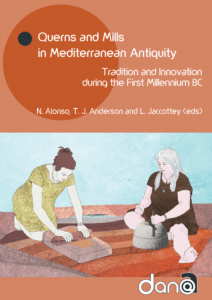UN@ est une plateforme d'édition de livres numériques pour les presses universitaires de Nouvelle-Aquitaine
Auteur : Sabine Nodin
Sabine Nodin received my degree in Archaeology and History and completed a Master’s degree at the School of Historical Sciences, University of Lille. The topic of her dissertation was ‘Lithic Tools Employed in Greek Ore-Processing Based on the Example of Thasos’ (2014-2016).
Her fieldwork experience was acquired in the Palaeolithic cave ‘La Caune de l’Arago’ at Tautavel and Vryokastro, Kythnos, Greece and post-excavation work experience at Thasos and Pistyros. Sabine Nodin have also recorded and studied a large volume of lithic tools: stone crushing tools, pounders, mortars, pestles and millstones from Thasos associated with the processing of ores used in metallurgy. She also participated in archaeometallurgical experimentation in 2016 in the framework of preliminary experimental ore crushing. She then received training in laboratory analytical techniques at N.C.S.R “Demokritos” and proceeded with the analysis of ores by the X-Ray Diffraction technique (XRD).
References
- Nodin, L’outillage lithique dans la minéralurgie grecque à partir de l’exemple de Thasos, Unpublished Master Dissertation, University of Lille 3 (2016).
- Nerantzis, S. Nodin and S. Papadopoulos,‘‘The organization of mining and metal production in Aegean Thrace from the Archaic to the Roman period”, in: F. Hulek and S. Nomicos (eds) Ancient Mining Landscapes, Panel 4.2, Archaeology and Economy in the Ancient World, Vol. 25, Heidelberg, Propylaeum (2022), p. 65‐84.
- Nodin and N. Nerantzis, ‘‘Processing of mineral resources and the organization of metal production in Thasos during the Early Bronze Age‘‘, 7th Symposium on Archaeometry of the Hellenic Society for Archaeometry ‘‘Archaeology-Archaeometry 30 years later’’, Athens, 9-12 October 2019, Byzantine and Christian Museum (in press).
- Nodin, ‘‘Ore processing techniques in Thasos during antiquity‘‘, in N. Nerantzis (ed.) Forging Values. Metals technologies in the Aegean and beyond from the 4th to the 1st millennium BCE, Études d’archéologie 20, CReA-Patrimoine, Bruxelles (2023), p. 81-92.
- N. Nerantzis, S. Nodin and S. Papadopoulos, ‘‘Urban metallurgy at Pistyros: investigating the contexts of production‘‘, in N. Nerantzis (ed.) Forging Values. Metals technologies in the Aegean and beyond from the 4th to the 1st millennium BCE, Études d’archéologie 20, CReA-Patrimoine, Bruxelles (2023), p. 93-105.
The hopper rubber is a grinding tool associated with the spread of the ancient Greek world throughout the Mediterranean. Its presence is certified at certain Greek or Greek-influenced sites in the southeast of France during the second half of first millennium BC (Py 1992; Chausserie-Laprée 1998; Frankel 2003; Jaccottey et al. 2013).


